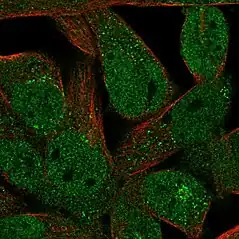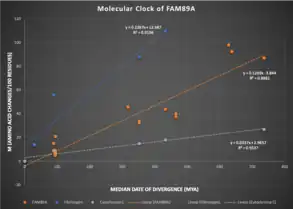Fam89A
Protein FAM89A (family with sequence similarity 89, member A) is a protein which in humans is encoded by the FAM89A gene. It is also known as chromosome 1 open reading frame 153 (C1orf153). Highest FAM89A gene expression is observed in the placenta and adipose tissue. Though its function is largely unknown, FAM89A is found to be differentially expressed in response to interleukin exposure, and it is implicated in immune responses pathways and various pathologies such as atherosclerosis and glioma cell expression.[5][6]
| FAM89A | |||||||||||||||||||||||||||||||||||||||||||||||||||
|---|---|---|---|---|---|---|---|---|---|---|---|---|---|---|---|---|---|---|---|---|---|---|---|---|---|---|---|---|---|---|---|---|---|---|---|---|---|---|---|---|---|---|---|---|---|---|---|---|---|---|---|
| Identifiers | |||||||||||||||||||||||||||||||||||||||||||||||||||
| Aliases | FAM89A, C1orf153, family with sequence similarity 89 member A | ||||||||||||||||||||||||||||||||||||||||||||||||||
| External IDs | MGI: 1916877 HomoloGene: 18887 GeneCards: FAM89A | ||||||||||||||||||||||||||||||||||||||||||||||||||
| |||||||||||||||||||||||||||||||||||||||||||||||||||
| |||||||||||||||||||||||||||||||||||||||||||||||||||
| |||||||||||||||||||||||||||||||||||||||||||||||||||
| |||||||||||||||||||||||||||||||||||||||||||||||||||
| Wikidata | |||||||||||||||||||||||||||||||||||||||||||||||||||
| |||||||||||||||||||||||||||||||||||||||||||||||||||
Gene

The gene FAM89A is a protein-encoding gene in humans, located on minus strand of chromosome 1, map position 1q42.2. It is also known as chromosome 1 open reading frame 153 (C1orf153).[7][8][9] The primary mRNA transcript for the FAM89A gene is 1,503 base pairs in length.[10] There are no other transcript variants for FAM89A. The gene is composed of two exons flanking one large intronic region.[11] FAM89A is neighboring the genes TRIM67 (Tripartite Motif Containing 67), located downstream of FAM89A on the plus strand of chromosome 1, and ARV1 (ARV1 Homolog, Fatty Acid Homeostasis Modulator), located upstream of FAM89A on the plus strand of chromosome 1.[11][12]
Protein
Biochemistry
The FAM89A protein is 184 amino acids in length, and it has a predicted molecular mass of 18.6kDa and a predicted isoelectric point of 5.64.[13] Two small repetitive sequences were found twice within the protein sequence; GARAA and ASGG. Composition of FAM89A protein is notable for its abundance of four amino acids; Leucine (14.1%), Glycine (12.0%), Alanine (11.4%) and Serine (11.4%). FAM89A shows five periodic repeats of leucine residues at every seventh amino acid position at positions 81-115, which is characteristic of its predicted leucine zipper structural motif.[14][15]
Conserved Domains
FAM89A contains a conserved leucine-rich adapter protein domain (LURAP) called PF14854, located at amino acid positions 84-122.[16][17] The LURAP superfamily of proteins are activators of the canonical NF-κB pathway, involved in promoting antigen presentation in dendritic cells and the production of pro-inflammatory cytokines.[18]
Secondary Structure
FAM89A is predicted to be 40% alpha helix, 11% extended strand, and 49% random coils.[19] The conserved LURAP domain is predicted to form an alpha helix.[20][21][22][23]
Tertiary Structure
FAM89A tertiary structure has not yet been determined by X-ray crystallography. I-TASSER software predicts dimerization of alpha helix monomers, indicative of the leucine zipper motif.[21][22][23]
Gene Level Regulation
Promoter

The FAM89A promoter region is 1,104 base pairs in length.[25] It contains binding sites for various transcription factors, including TFIIB (RNA polymerase II transcription factor IIB), PLAG1 (pleomorphic adenoma gene 1), MZF1 (myeloid zinc finger 1 factors), and SP1 (GC-Box factors SP1/GC).[11][25]
Expression pattern
FAM89A's highest expression is observed in the placenta and adipose tissue.[26][27] RNA-sequencing data also reveals moderate FAM89A expression in the adrenal gland, lung, skin, spleen, and breast.[8][12] Microarray hybridization supports high FAM89A expression in the placenta and moderate expression in the lung, spinal cord, skin, adrenal gland, and retina.[28]
Protein Level Regulation
Subcellular Localization
The FAM89A protein is suggested to be localized in the nucleoplasm, Golgi apparatus, and/or vesicles.[29][30] Reinhardt’s method for cytoplasmic/nuclear discrimination in PSORT II search results predict nuclear localization with a reliability score of 89. Prediction for localization of FAM89A is highest in the nucleus (52.2%) followed by the mitochondria (34.8%), then the cytoskeleton (8.7%), followed by the cytoplasm having the lowest score (4.3%).[14] PredictProtein tool supports the prediction of subcellular localization in the nucleus.[31]
Phosphorylation/O-Linked β-N-acetylglucosamine
FAM89A has three predicted phosphorylation sites located at amino acid positions 30, 32, and 168 that are conserved in distant orthologs.[32] The predicted phosphorylation site at position 32 is experimentally verified at position 28 in its paralog, FAM89B.[33] There is a possible competitive binding site for phosphorylation and O-linked β-N-acetylglucosamine (O-GlcNAc) at position 158,[34] supporting localization of FAM89A in the nucleoplasm.[29][30]

Glycation
NetGlycate 1.0 server predicts two glycation sites at positions 57 and 95.[35] The residues are conserved in distant FAM89A orthologs. Glycation of these lysines is linked to being an important factor in atherosclerosis due to its production of advanced glycation end products (AGEs) which are engulfed by macrophages and taken into the arterial wall.[36]
SUMOylation
SUMOplot predicts SUMO (Small Ubiquitin-like Modifier) protein sites at position 83. The residue is conserved in distant FAM89A orthologs.
Homology/Evolution
Paralogs
An important human paralog of FAM89A is FAM89B, located on human chromosome 11 at map position 11q13.1.[37] FAM89B is also known as, Leucine Repeat Adaptor Protein 25 (LRAP25) and Mammary Tumor Virus Receptor Homolog 1 (MTVR1).[37] Orthologs of FAM89A, but not FAM89B, are present in bivalves, crinoids, hemichordates, starfish, and horseshoe crabs.[38] Orthologs of FAM89B, but not FAM89A, are present in brachiopods and priapulids, The paralogs likely split around 736 million years ago.[39]
Orthologs
FAM89A is largely conserved in Eutelostomi (bony vertebrates). Its orthologs can be found in mammals, amphibians, reptiles, birds, fish, and various insects.[40] Distant FAM89A orthologs are present in octopus, scallop, ants, and bees.[41][42][43][44]

Evolution
The rate of accumulation of amino acid changes relative to the genes Fibrinogen and Cytochrome c indicates that FAM89A is evolving rapidly, using the molecular clock technique.
Interacting Proteins
FAM89A is experimentally determined to interact with the UBXN2B (UBX Domain Protein 2B), an adaptor protein involved in biogenesis in the Golgi apparatus and endoplasmic reticulum (ER) and assembly and maintenance of the ER during the cell cycle[45][46]
Clinical Significance
Pathology and Disease Association
FAM89A is suggested to be involved in modulating the effects of smoking on the risk of atherosclerotic plaque burden.[5] In a study conducted in 2014, a cohort of 264 Caribbean Hispanics with varying smoking frequencies were evaluated for carotid plaque burden and 11 single nucleotide polymorphism (SNP) were identified that had a notable interaction with smoking effects on carotid plaque burden, including SNP rs6700792, located within the FAM89A gene.[5]
FAM89A is also suggested to be involved in discriminating viral and bacterial infection in febrile patients.[6] A 2016 study conducted at the Division of Infectious Disease in the Imperial College of London evaluated blood-based transcriptomic biomarkers and revealed that febrile patients with bacterial infection displayed increased expression of FAM89A.[47][48]
A 2019 study concerning FAM89A was directed on genes that possess methylation sites that relate to causing gliomas. The researchers found that abnormal expression of FAM89A correlated with glioma gene expression profiling studies.[49]
Microarray hybridization data revealed slight decrease in FAM89A expression in response to airway epithelial cell exposure to interleukin 13 and CD8+ T lymphocyte exposure to interleukin 10.[50][51]
References
- GRCh38: Ensembl release 89: ENSG00000182118 - Ensembl, May 2017
- GRCm38: Ensembl release 89: ENSMUSG00000043068 - Ensembl, May 2017
- "Human PubMed Reference:". National Center for Biotechnology Information, U.S. National Library of Medicine.
- "Mouse PubMed Reference:". National Center for Biotechnology Information, U.S. National Library of Medicine.
- Della-Morte, David; Wang, Liyong; Beecham, Ashley; Blanton, Susan H.; Zhao, Hongyu; Sacco, Ralph L.; Rundek, Tatjana; Dong, Chuanhui (2014-09-15). "Novel Genetic Variants Modify the Effect of Smoking on Carotid Plaque Burden in Hispanics". Journal of the Neurological Sciences. 344 (1–2): 27–31. doi:10.1016/j.jns.2014.06.006. ISSN 0022-510X. PMC 4143440. PMID 24954085.
- Gómez-Carballa, Alberto; Cebey-López, Miriam; Pardo-Seco, Jacobo; Barral-Arca, Ruth; Rivero-Calle, Irene; Pischedda, Sara; Currás-Tuala, María José; Gómez-Rial, José; Barros, Francisco; Martinón-Torres, Federico; Salas, Antonio (2019-08-13). "A qPCR expression assay of IFI44L gene differentiates viral from bacterial infections in febrile children". Scientific Reports. 9 (1): 11780. Bibcode:2019NatSR...911780G. doi:10.1038/s41598-019-48162-9. ISSN 2045-2322. PMC 6692396. PMID 31409879.
- "Transcript: FAM89A-001 (ENST00000366654.4) - Summary - Homo sapiens - GRCh37 Archive browser 100". grch37.ensembl.org. Retrieved 2020-05-02.
- "FAM89A protein expression summary - The Human Protein Atlas". www.proteinatlas.org. Retrieved 2020-05-02.
- "Parental Gene". www.bioinfo.mochsl.org.br. Retrieved 2020-05-02.
- "AceView: Gene:FAM89A, a comprehensive annotation of human, mouse and worm genes with mRNAs or ESTsAceView". www.ncbi.nlm.nih.gov. Retrieved 2020-05-02.
- "Human hg38 chr1:231,018,958-231,040,254 UCSC Genome Browser v397". genome.ucsc.edu. Retrieved 2020-05-03.
- "FAM89A family with sequence similarity 89 member A [Homo sapiens (human)] - Gene - NCBI". www.ncbi.nlm.nih.gov. Retrieved 2020-05-03.
- "ExPASy - Compute pI/Mw tool". web.expasy.org. Retrieved 2020-05-02.
- "PSORT II Prediction". psort.hgc.jp. Retrieved 2020-05-03.
- "SAPS < Sequence Statistics < EMBL-EBI". www.ebi.ac.uk. Retrieved 2020-05-03.
- "CDD Conserved Protein Domain Family: LURAP". www.ncbi.nlm.nih.gov. Retrieved 2020-05-02.
- "RecName: Full=Protein FAM89A - Protein - NCBI". www.ncbi.nlm.nih.gov. Retrieved 2020-05-02.
- "CDD Conserved Protein Domain Family: LURAP". www.ncbi.nlm.nih.gov. Retrieved 2020-05-03.
- "NPS@ : GOR4 secondary structure prediction". npsa-prabi.ibcp.fr. Retrieved 2020-05-03.
- "CFSSP: Chou & Fasman Secondary Structure Prediction Server". www.biogem.org. Retrieved 2020-05-03.
- Zhang, Yang (2009). "I-TASSER: Fully automated protein structure prediction in CASP8". Proteins: Structure, Function, and Bioinformatics. 77 (S9): 100–113. doi:10.1002/prot.22588. ISSN 0887-3585. PMC 2782770. PMID 19768687.
- Roy, Ambrish; Yang, Jianyi; Zhang, Yang (2012-05-08). "COFACTOR: an accurate comparative algorithm for structure-based protein function annotation". Nucleic Acids Research. 40 (W1): W471–W477. doi:10.1093/nar/gks372. ISSN 0305-1048. PMC 3394312. PMID 22570420.
- Yang, Jianyi; Zhang, Yang (2015-04-16). "I-TASSER server: new development for protein structure and function predictions". Nucleic Acids Research. 43 (W1): W174–W181. doi:10.1093/nar/gkv342. ISSN 0305-1048. PMC 4489253. PMID 25883148.
- "Cell atlas - FAM89A - The Human Protein Atlas". www.proteinatlas.org. Retrieved 2020-05-03.
- "ElDorado: Annotation & Analysis". www.genomatix.de. Retrieved 2020-05-03.
- "FAM89A - Protein FAM89A - Homo sapiens (Human) - FAM89A gene & protein". www.uniprot.org. Retrieved 2020-05-02.
- "Gene: FAM89A - ENSG00000182118". bgee.org. Retrieved 2020-05-02.
- "GDS3113 / 211045". www.ncbi.nlm.nih.gov. Retrieved 2020-05-03.
- "FAM89A Gene - GeneCards | FA89A Protein | FA89A Antibody". www.genecards.org. Retrieved 2020-05-03.
- "FAM89A - Antibodies - The Human Protein Atlas". www.proteinatlas.org. Retrieved 2020-05-03.
- "PredictProtein - Protein Sequence Analysis, Prediction of Structural and Functional Features".
- "NetPhos 3.1 Server". www.cbs.dtu.dk. Retrieved 2020-05-03.
- "RecName: Full=Leucine repeat adapter protein 25 - Protein - NCBI". www.ncbi.nlm.nih.gov. Retrieved 2020-05-03.
- "YinOYang 1.2 Server". www.cbs.dtu.dk. Retrieved 2020-05-03.
- "NetGlycate 1.0 Server". www.cbs.dtu.dk. Retrieved 2020-05-03.
- Seetharaman, Shyam (2016). "The Influences of Dietary Sugar and Related Metabolic Disorders on Cognitive Aging and Dementia". Molecular Basis of Nutrition and Aging. Elsevier. pp. 331–344. doi:10.1016/b978-0-12-801816-3.00024-8. ISBN 978-0-12-801816-3.
- "FAM89B Gene - GeneCards | LRA25 Protein | LRA25 Antibody". www.genecards.org. Retrieved 2020-05-02.
- "BLAST: Basic Local Alignment Search Tool". blast.ncbi.nlm.nih.gov. Retrieved 2020-05-03.
- "TimeTree :: The Timescale of Life". www.timetree.org. Retrieved 2020-05-03.
- "ortholog_gene_375061[group] - Gene - NCBI". www.ncbi.nlm.nih.gov. Retrieved 2020-05-03.
- "protein FAM89A-like [Mizuhopecten yessoensis] - Protein - NCBI". www.ncbi.nlm.nih.gov. Retrieved 2020-05-03.
- "protein FAM89A-like [Octopus vulgaris] - Protein - NCBI". www.ncbi.nlm.nih.gov. Retrieved 2020-05-03.
- "Protein FAM89A [Cyphomyrmex costatus] - Protein - NCBI". www.ncbi.nlm.nih.gov. Retrieved 2020-05-03.
- "Protein FAM89A [Eufriesea mexicana] - Protein - NCBI". www.ncbi.nlm.nih.gov. Retrieved 2020-05-03.
- "FAM89A protein (human) - STRING interaction network". string-db.org. Retrieved 2020-05-03.
- "UBXN2B Gene - GeneCards | UBX2B Protein | UBX2B Antibody". www.genecards.org. Retrieved 2020-05-03.
- Herberg, Jethro A.; Kaforou, Myrsini; Wright, Victoria J.; Shailes, Hannah; Eleftherohorinou, Hariklia; Hoggart, Clive J.; Cebey-López, Miriam; Carter, Michael J.; Janes, Victoria A.; Gormley, Stuart; Shimizu, Chisato (2016-08-23). "Diagnostic Test Accuracy of a 2-Transcript Host RNA Signature for Discriminating Bacterial vs Viral Infection in Febrile Children". JAMA. 316 (8): 835–845. doi:10.1001/jama.2016.11236. ISSN 0098-7484. PMC 5997174. PMID 27552617.
- Kaforou, Myrsini; Herberg, Jethro A.; Wright, Victoria J.; Coin, Lachlan J. M.; Levin, Michael (2017-04-18). "Diagnosis of Bacterial Infection Using a 2-Transcript Host RNA Signature in Febrile Infants 60 Days or Younger". JAMA. 317 (15): 1577–1578. doi:10.1001/jama.2017.1365. hdl:10044/1/64273. ISSN 0098-7484. PMID 28418473. S2CID 35672762.
- Pan, XiaoYong; Zeng, Tao; Yuan, Fei; Zhang, Yu-Hang; Chen, Lei; Zhu, LiuCun; Wan, SiBao; Huang, Tao; Cai, Yu-Dong (2019-11-14). "Screening of Methylation Signature and Gene Functions Associated With the Subtypes of Isocitrate Dehydrogenase-Mutation Gliomas". Frontiers in Bioengineering and Biotechnology. 7: 339. doi:10.3389/fbioe.2019.00339. ISSN 2296-4185. PMC 6871504. PMID 31803734.
- "GDS4981 / ILMN_2285817". www.ncbi.nlm.nih.gov. Retrieved 2020-05-03.
- "GDS4217 / 10582694". www.ncbi.nlm.nih.gov. Retrieved 2020-05-03.



